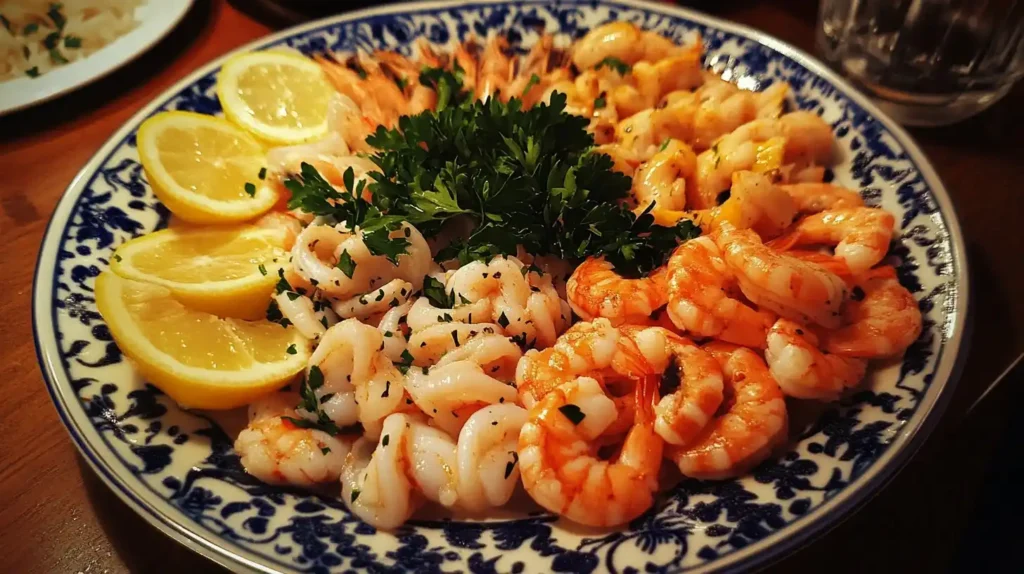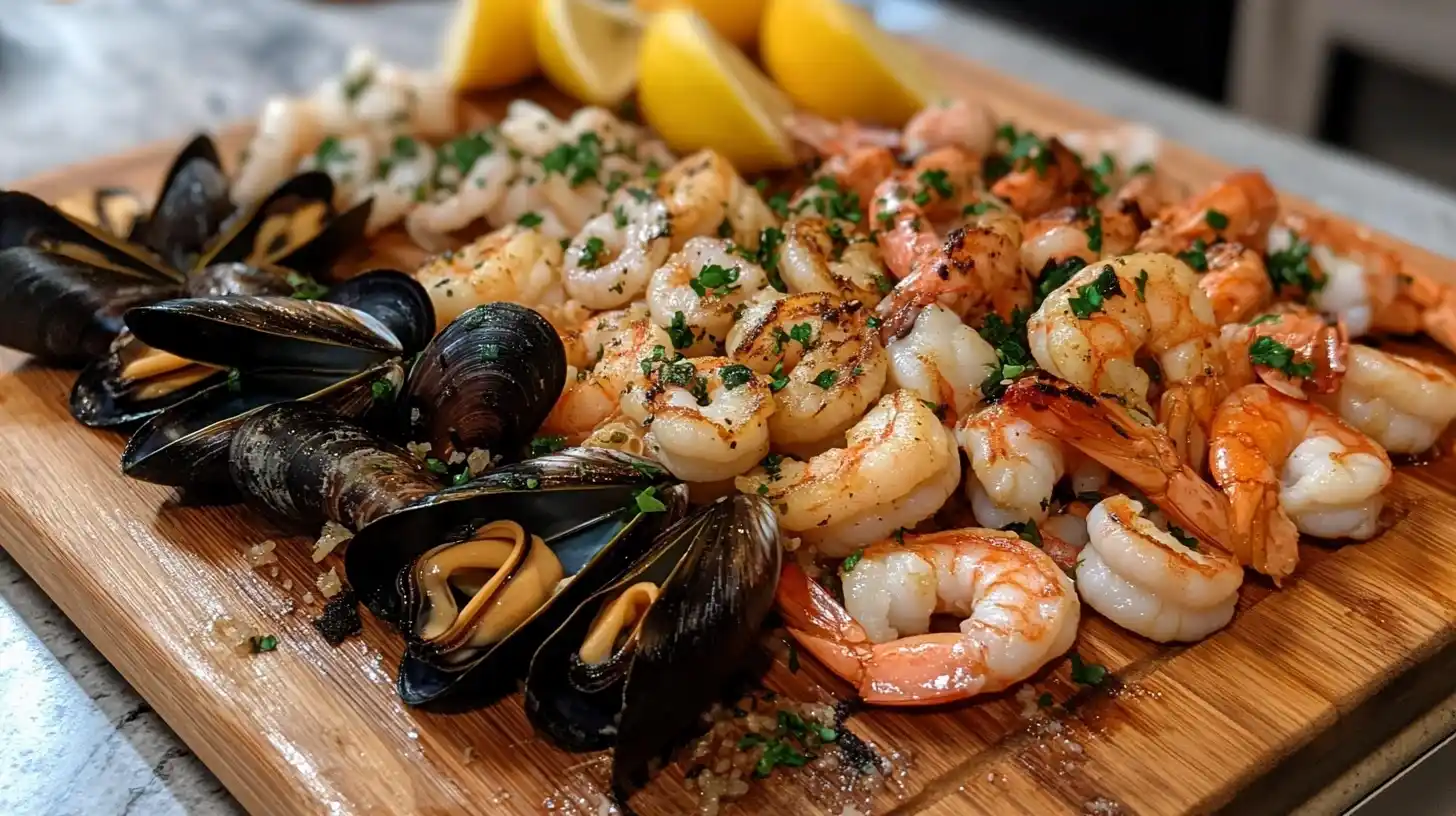Seafood mix is a versatile and popular ingredient in many cuisines, offering a combination of flavors and textures that are ideal for a wide range of dishes. Whether you’re preparing a hearty seafood paella or a light pasta, understanding what is in the seafood mix can help you choose the best option for your meal. More importantly, knowing the ingredients ensures compliance with dietary needs, such as avoiding alcohol or pork-based products.
Seafood mixes generally include a variety of shellfish and fish. However, it’s essential to check the labels for certifications such as halal or kosher, ensuring that the product meets specific dietary restrictions. For more information on choosing the right seafood sustainably, you can explore MSC’s Sustainable Seafood Guide.
Table of contents
What Does a Seafood Mix Include?
It is often a mix of seafood types that come together to create a flavorful base for many recipes. While the exact combination can vary by brand or region, here are the most common ingredients:
- Shrimp
Shrimp is one of the most popular seafood items in a mix. It is rich in protein and low in fat, making it a healthy choice. Its mild flavor blends well with other ingredients, and it’s perfect for stir-fries, soups, or pasta dishes. - Mussels and Clams
These shellfish add a briny taste to the mix. They are also packed with iron, selenium, and vitamin B12, which are great for boosting energy and supporting brain health. - Squid (Calamari)
Squid provides a slightly chewy texture and works wonderfully in fried dishes or stews. It’s a good source of protein and essential minerals like zinc and copper. - Crab or Imitation Crab Meat
Crab, or imitation crab made from fish, adds a touch of sweetness. It’s widely used in sushi, seafood salads, or creamy soups. - Fish Fillets
White fish like cod, pollock, or haddock is often included for its tender and flaky texture. It balances the mix with a subtle, mild taste.
For more details about similar seafood options, you might enjoy reading Everything You Need to Know About Seafood Mix, which dives deeper into seafood varieties and their uses.

Seafood mixes are available in fresh or frozen varieties. Each mix varies depending on its intended use and cultural preferences. Some even include exotic additions like octopus or scallops for a unique flavor.
Nutritional Benefits of Seafood Mix
Seafood mix is not only delicious but also a fantastic source of essential nutrients. Moreover, it is a great addition to your meals if you are aiming for a balanced diet. Let’s explore why it is so good for your health.
Packed with Protein
Firstly, seafood mix is rich in protein, which is vital for building and repairing tissues in the body. Additionally, protein helps maintain muscle mass and keeps you feeling full for longer. As a result, it’s an excellent option for anyone looking to stay fit or manage their weight.
Loaded with Vitamins and Minerals
Seafood mix provides a variety of essential vitamins and minerals. For example, it contains selenium, which supports a healthy immune system, and zinc, which aids in wound healing. Furthermore, it is an excellent source of vitamin B12, which boosts energy and keeps your brain sharp.
High in Omega-3 Fatty Acids
One of the standout benefits of seafood mix is its omega-3 fatty acids. These healthy fats are crucial for heart and brain health. Additionally, omega-3s help reduce inflammation and may even lower the risk of chronic diseases, such as heart disease.
Low in Calories, High in Nutrients
Another great thing about seafood mix is that it is low in calories while being nutrient-dense. Because of this, it’s a perfect choice for those who want to eat healthily without feeling deprived.
Be Aware of Allergies
While seafood mix offers numerous benefits, it’s essential to note that some people may be allergic to shellfish or fish. Therefore, always check the ingredients and consult a doctor if you have concerns about allergies.
Including seafood mix in your meals is a simple and effective way to boost your health. For more insights on how seafood supports a nutritious lifestyle, check out the Seafood Nutrition Partnership.

How to Choose the Right Seafood Mix
Selecting the perfect seafood mix can feel overwhelming, but with the right tips, it becomes much easier. Additionally, making informed choices ensures you get the best quality and meet your dietary needs. Let’s go through the essential steps to pick the right mix.
1. Read the Label Carefully
When choosing a seafood mix, always check the label. Labels provide key information about the ingredients, nutritional values, and certifications. For example:
- Look for products labeled as halal or kosher if these align with your dietary practices.
- Avoid mixes with unnecessary additives or preservatives. These can affect the taste and nutritional value.
Moreover, reading the label helps you confirm that the mix is free from allergens, such as shellfish, if necessary.
2. Fresh vs. Frozen Seafood
Next, decide between fresh and frozen options. While fresh seafood might seem ideal, frozen mixes are often just as good because they are preserved at their peak freshness. Consider these points:
- Fresh seafood is best for meals where flavor and texture matter most.
- Frozen mixes are convenient and usually more affordable. Just make sure they are properly stored, without ice crystals or freezer burns.
Frozen options are also ideal for those who like to keep seafood on hand for quick, last-minute meals.
3. Sustainability is Key
Choosing sustainable seafood is better for the environment and future generations. To make the best decision:
- Look for certifications like the MSC (Marine Stewardship Council) or ASC (Aquaculture Stewardship Council). These labels indicate the seafood was responsibly sourced.
- Avoid products from overfished species, as they harm marine ecosystems.
Sustainability doesn’t only protect the planet; it also ensures you are eating healthier seafood with fewer environmental contaminants.
4. Practical Buying Tips
Finally, use these tips to make your shopping experience smoother:
- Buy seafood mixes that suit your recipe needs. For example, choose a mix with squid and mussels for paella or one with fish fillets for soup.
- Check expiration dates to ensure freshness.
- Store your seafood properly to maintain quality and safety. Thaw frozen seafood in the fridge for the best results.
Recipes and Preparation Tips for Seafood Mix
Cooking with a seafood mix is both simple and rewarding. Because it’s so versatile, you can create a wide variety of dishes, from hearty soups to light pasta. Let’s explore some easy recipes and preparation tips to help you make the most of this ingredient.
Popular Recipes Using Seafood Mix
- Seafood Paella
Paella is a classic Spanish dish that’s both flavorful and filling. To make it:- Combine seafood mix with rice, saffron, and vegetables like bell peppers and peas.
- Cook everything in a large pan, allowing the flavors to blend perfectly.
- Serve hot, garnished with fresh parsley.
- Seafood Stir-Fry
A stir-fry is a quick and healthy way to enjoy your seafood mix. Simply:- Heat a bit of oil in a pan, then add garlic and ginger for aroma.
- Toss in your seafood mix with vegetables like broccoli, carrots, or bell peppers.
- Add soy sauce or teriyaki sauce for a savory finish.
- Seafood Soup
A warm bowl of seafood soup is comforting, especially on cold days. Here’s how:- Simmer your seafood mix with tomatoes, garlic, onions, and a pinch of chili flakes.
- Add fish stock or vegetable broth for depth of flavor.
- Let it cook for a few minutes until everything is tender, and serve with crusty bread.

Cooking Tips for the Best Results
To get the most out of your seafood mix, follow these tips:
- Don’t Overcook: Overcooking can make seafood rubbery and unpleasant. Instead, cook it gently until just done.
- Thaw Properly: If using frozen seafood, always thaw it in the refrigerator rather than at room temperature. This prevents bacterial growth.
- Season Lightly: Seafood has a natural flavor, so you don’t need heavy seasonings. A little garlic, lemon, or parsley goes a long way.
Avoiding Common Mistakes
While cooking seafood mix is easy, there are a few common pitfalls to watch out for:
- Over-seasoning: Too much salt or spice can overpower the delicate flavors of seafood.
- Mixing Fresh and Frozen: Always use either all fresh or all frozen seafood to ensure even cooking.
- Not Reading the Label: Some mixes may contain added sodium or unexpected ingredients, so check carefully.
Cooking with seafood mix allows you to explore a world of flavors while maintaining a healthy diet. For more inspiration, you can always experiment with different seasonings and cooking methods.
FAQs About Seafood Mix
Seafood mix is a popular ingredient, but you may still have questions about it. Below, we address some of the most common queries to help you understand and enjoy this versatile food.
What is typically included in a seafood mix?
A seafood mix usually includes a variety of seafood items, such as shrimp, squid, mussels, clams, and fish fillets. Some mixes may also feature imitation crab or scallops. Because ingredients vary between brands, it’s always a good idea to read the label to know exactly what you’re getting.
Can seafood mix be halal or kosher-certified?
Yes, many seafood mixes are certified halal or kosher, making them suitable for specific dietary requirements. To ensure the mix meets your needs, look for certification logos or labels on the packaging. Additionally, avoid products containing any non-halal or non-kosher additives, such as alcohol.
Are there shellfish-free seafood mixes?
Yes, some brands offer mixes that exclude shellfish, focusing instead on fish-only options. These are ideal for individuals with shellfish allergies or those who prefer to avoid shellfish for other reasons. If you are unsure, check the label or ask the supplier for more details.
How can I tell if a seafood mix is fresh?
To determine freshness:
- Check for a clean, ocean-like smell. A strong, fishy odor can be a sign of spoilage.
- Look for bright, firm seafood with no discoloration. Dull or slimy textures often indicate poor quality.
- For frozen mixes, avoid packages with excessive ice crystals or freezer burns.
What are the best ways to store and thaw a seafood mix?
Proper storage and thawing are essential to maintaining quality:
- Store frozen seafood in the coldest part of the freezer.
- Thaw it slowly in the refrigerator rather than leaving it at room temperature. This method helps prevent bacteria growth and keeps the texture intact.
- Use the mix within a day or two of thawing to ensure freshness.
Is a seafood mix a healthy choice?
Absolutely! Seafood mix is rich in protein, low in fat, and packed with essential nutrients like omega-3 fatty acids, selenium, and vitamin B12. These nutrients support heart health, brain function, and overall wellness. As long as you avoid heavily processed or overly salty versions, seafood mix is an excellent addition to your diet.
Seafood mix is a convenient, nutritious, and versatile ingredient that suits many recipes and dietary needs. By addressing these common questions, we hope you feel more confident using and enjoying it in your cooking.
Conclusion: Understanding and Enjoying Seafood Mix
Seafood mix is a versatile and nutritious ingredient that can elevate many dishes, from hearty soups to elegant pasta. Because it includes a variety of seafood items like shrimp, squid, and mussels, it offers a delightful combination of flavors and textures. Additionally, its rich nutritional profile makes it a healthy choice for anyone looking to enjoy a balanced diet.
When choosing a seafood mix, always take the time to read labels carefully. This step ensures that the product meets your dietary requirements, whether you need it to be halal, kosher, or allergen-free. Moreover, considering options with certifications like the MSC label supports sustainability and helps protect marine ecosystems for the future.
If you’re new to cooking with seafood mix, don’t worry. Start with simple recipes like stir-fries or soups, and use gentle cooking methods to retain its natural flavors. By following basic tips, such as thawing frozen seafood properly and avoiding overcooking, you can create dishes that are both delicious and healthy.
In conclusion, seafood mix is more than just a convenient option—it’s a gateway to exploring a variety of flavors and cultures. With a little knowledge and preparation, you can make the most of this ingredient while enjoying its numerous health benefits. So, the next time you’re planning a meal, why not give seafood mix a try? It’s a choice you won’t regret!

